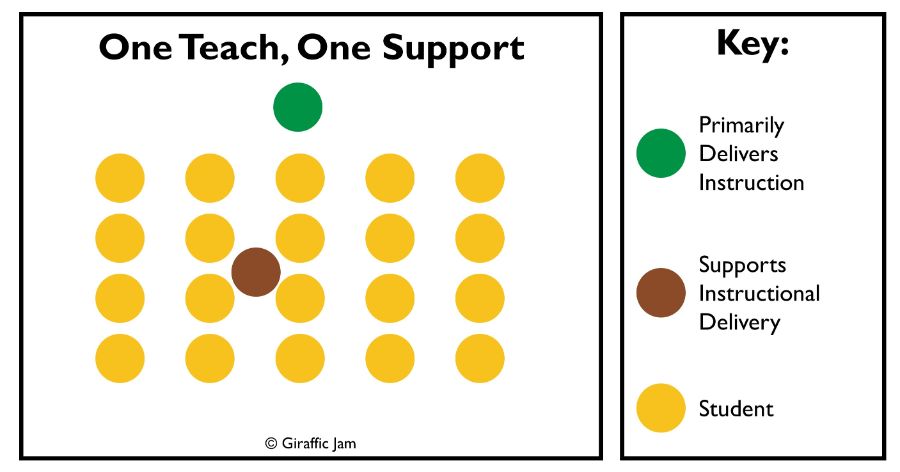
One teach, one support is a great co-teaching strategy to try. It’s a perfect strategy to try for those new to co-teaching. One support teaching is when one adult delivers instruction as the primary teacher and the other adult supports by helping students, passing out materials, and answering questions.
There are six different types of co-teaching. No matter which of the types of co-teaching you use, you and your co-teacher can be highly effective instructors when you work together to plan and deliver lessons. Co-teaching works, because it involves two adults actively working together to provide instruction.
Simply put, co-teaching is when two adults work together to teach a lesson. Notice, I say ‘adults’ not teachers. Why? It’s simple really, it could be two teachers. Or, it could be an intern and a teacher. Or, a substitute and a teacher…. An instructional assistant and a teacher… A substitute and an instructional assistant. Or…..
Well, I guess you get where I’m going with this. However, old habits die hard so throughout this post you’ll see me refer to the adults as ‘teachers’. Just don’t limit yourself to thinking of teachers only in the traditional sense!
Don’t be limited to thinking that co-teaching is always a gen ed teacher and a special education teacher. It can be, but it doesn’t have to be. If you think outside the box, you might find that you have more opportunities for co-teaching than you realize!
One teach, one support co-teaching is when one teacher assumes the responsibility of leading the instruction. The other teacher supports by helping students or the lead teacher. This works well in many settings, and is probably the easiest to do ‘on the fly’. The support teacher can help students by clarifying questions, providing proximity control, passing out materials, or monitoring student work.

In one teach one support teaching, one teacher leads the instruction while the other supports students. The supporting teacher might help with materials, offer proximity control classroom management, or support students one on one during the lesson.
This is a great way to ensure students who need a little extra help are getting it, without removing them from the general education environment. This method of co-teaching allows for all students to receive the same lesson, but those who need additional support can get it. Students who require proximity control can get it, as well as students who need accommodations and supplementary aids.
Using this co-teaching strategy too often can result in students seeing one adult as the ‘real teacher’ and one as the ‘helper’. And, that can cause some difficulty with classroom management and respect from students. This strategy should be used sparingly and both adults should rotate roles. One person should not always be the support person.
The support person should be familiar with the lesson and help plan it. It’s important that they are actively involved in planning and implementing the lesson. Make sure you are clear from the beginning what the support persons role will be – otherwise, you may notice that the support person is just hanging out in the background or doing off-task activities.
Co-Teaching can be hard. If you’re looking for more information, check out this blog post to read some of my favorite tips and tricks for getting the ball rolling!
Co-teaching is an effective tool for reaching all of your learners. It allows both teachers the opportunity to see students and their progress. When you use parallel teaching as your co-teaching method, it gives the students the chance to see the lesson in a smaller group setting. Did you know there are five other types of co-teaching? Check them out here!